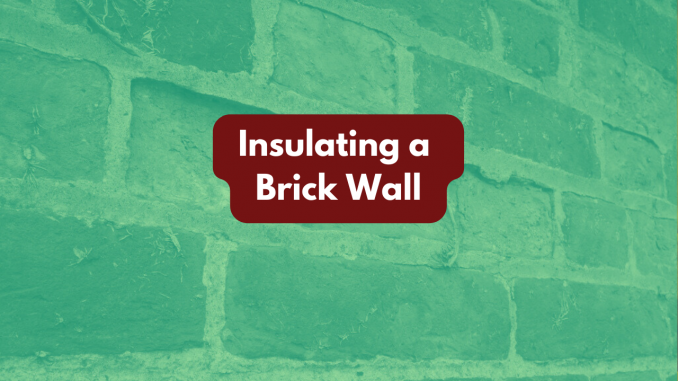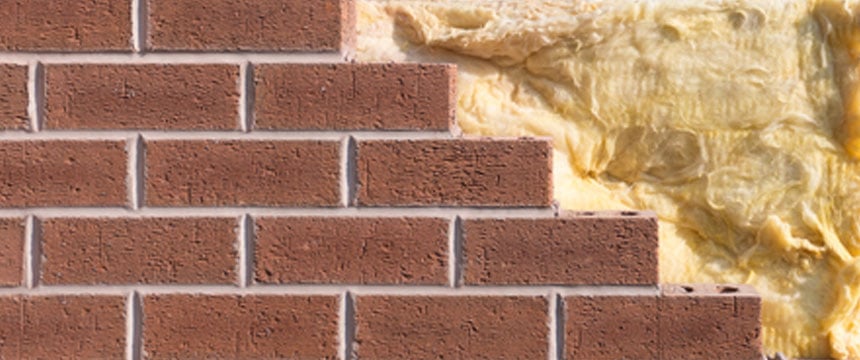
How to insulate a brick wall and reduce heat loss during winters and heat gain during summers.
A comfortable and energy-efficient home, insulation plays a crucial role. For homeowners with single brick walls, ensuring proper insulation is even more important. Single brick walls, while charming, can be notorious for their poor thermal performance. However, with the right techniques and materials, you can significantly improve the insulation of a single brick wall, reducing energy consumption and enhancing indoor comfort. In this blog post, we will explore effective methods to insulate a single brick wall, ensuring you achieve optimal results.
Single Brick Wall Insulation
Internal wall insulation is typically employed in homes with brickwork, especially on single brick walls. This involves placing insulation material between the brick and plasterboard layers of the wall. To do this, you’ll need a stud wall along with insulating rolls or a comparable product. Another option is to use insulated plasterboard.
Understanding the Challenge
Before delving into the insulation techniques, it’s vital to understand the unique challenges posed by single brick walls. Unlike double brick walls or those with additional insulation layers, single brick walls lack inherent thermal resistance. They conduct heat easily, leading to heat loss during winters and heat gain during summers. Consequently, this can result in higher energy bills and an uncomfortable living environment, especially for those with high ceilings or tall houses.
External Wall Insulation (EWI)
One of the most effective ways to insulate a single brick wall is through External Wall Insulation (EWI). EWI involves adding an insulating layer to the exterior surface of the brick wall. This method not only prevents heat loss but also helps in reducing condensation and damp issues. Materials commonly used for EWI include expanded polystyrene (EPS), mineral wool, and polyurethane.
Internal Wall Insulation (IWI)
If altering the exterior of your property is not an option, Internal Wall Insulation (IWI) is an alternative worth considering. With IWI, insulation boards are fixed to the interior surface of the brick wall. While this method is less intrusive, it may slightly reduce the room’s dimensions. However, IWI can be a cost-effective way to improve thermal efficiency.

Cavity Wall Insulation
In some cases, single brick walls may have a cavity between the internal and external leaf. Cavity Wall Insulation involves injecting insulating material into this gap, effectively reducing heat transfer. While this method is more suitable for cavity walls, it can provide moderate insulation for single brick walls with cavities.
Lime Plastering
For those seeking a more traditional approach to insulation, lime plastering is a viable choice. Lime plaster is a breathable material that can regulate moisture, reducing the risk of dampness. Additionally, lime plaster has insulating properties, improving the thermal performance of single brick walls while maintaining their original aesthetics.
Insulated Drylining
Insulated drylining is another internal insulation method that involves fixing a stud frame against the brick wall and filling it with insulation material. This technique provides enhanced insulation and can accommodate electrical wiring or additional fixtures.
Properly insulating a single brick wall is essential to create a comfortable living space while reducing energy consumption. Whether you opt for External Wall Insulation, Internal Wall Insulation, Cavity Wall Insulation, lime plastering, or insulated drylining, each method has its advantages.
Consider consulting a professional to determine the most suitable insulation approach based on your budget, climate, and structural requirements. By taking this crucial step towards better insulation, you’ll not only enjoy a more comfortable home year-round but also contribute to a greener, more sustainable future.
Frequently asked questions
Why should I insulate my single brick wall?
Homeowners often inquire about the benefits of insulating single brick walls. Addressing this query involves explaining the advantages, such as improved energy efficiency, reduced heating and cooling costs, and enhanced indoor comfort.
What are the common insulation options for single brick walls?
This question seeks to understand the available insulation methods, including External Wall Insulation (EWI), Internal Wall Insulation (IWI), Cavity Wall Insulation, lime plastering, and insulated drylining.
Is it possible to insulate a single brick wall from the inside?
Homeowners with constraints on altering the external appearance of their homes often inquire about the feasibility and effectiveness of internal insulation methods like IWI or insulated drylining.
Will insulating a single brick wall affect its appearance?
Many people worry about compromising the charm and aesthetics of their single brick walls after insulation. Answering this question involves discussing how certain methods like EWI or lime plastering can maintain the original appearance while enhancing thermal performance.
How much will it cost to insulate a single brick wall?
Cost considerations are crucial for homeowners. Addressing this question requires an explanation of the various factors influencing the overall cost, such as the chosen insulation method, the size of the wall, and labour expenses.
Which insulation method offers the best energy-saving potential?
Homeowners seek clarity on which insulation method will yield the most significant energy-saving benefits, helping them make informed decisions for long-term sustainability and cost savings.
Can I install insulation myself, or do I need professional assistance?
Many homeowners wonder if they can undertake the insulation project as a DIY endeavour or if they should hire professionals to ensure proper installation and avoid potential issues.
Are there any grants or incentives available for single brick wall insulation?
Some homeowners may inquire about government or utility company incentives, tax credits, or grants available to support energy-efficient home improvements.
How long does the insulation installation process take?
Understanding the time frame involved in the insulation process is essential for homeowners to plan accordingly and minimize any disruption to their daily routines.
Can you still insulate if the bricks need repairing?
Insulating bricks that are spalling is not recommended and we advise getting bricks repaired if they are spalling.
Will insulating a single brick wall prevent condensation and damp issues?
Homeowners often want to know if insulation will address or exacerbate condensation and dampness concerns associated with single brick walls.


Leave a Reply